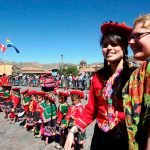This article was posted on Saturday, September 5th, 2015 at 5:47 am and is filed under Tours of Peru.

When looking for places to visit in Peru, don’t forget to put the tropical rainforest on your list, right next to journeys from Lima to Machu Picchu. The rainforest is a place where much of the wildlife lives in the forest canopy, and where two of the most recognizable birds in the world, the toucan and the macaw, flourish.
The Place they call Home
The Amazonian rainforest is home to more than one third of the world’s species of birds, hundreds of species of trees, and hundreds of thousands of plants. The macaws and toucans of the rainforest call the area about 100 feet off the ground– the forest canopy – their home.
The canopy is dense, rich, and full of places for shelter, hiding and, of course, food. It is also a place with an abundance of sunlight, leaving the canopy hot during the day, whilst the forest floor is cool and dark. Toucans and macaws share this home, but how they eat, how they socialize and how they navigate the forest canopy are quite different.
What’s the difference between a Bill and a Beak?
Toucans, which are a species all their own, and macaws, which are part of the parrot family, each have powerful claws, colorful plumage, and beaks (bills) adapted for eating. According to the dictionary, a bill is a beak and a beak is a bill, at least when it comes to birds. Whatever you call them, though, the differences in the bills/beaks of the toucan and macaw are striking, and not just for the obvious reasons.
The toucan’s colorful bill is massive, but it is relatively light. Made of keratin, the substance in the hair and nails of animals like humans, a toucan’s bill is also proportionately larger than any other bird in the world.
The relatively light bill contains arteries that expand when they get hot; this releases heat and helps the toucan stay cool in the hot environment of the forest canopy. This adaptation is one of the best temperature regulating systems I the entire animal kingdom.
Called “softbills,” more for the food they eat than for the nature of their beaks, Toucans eat mostly fruits and nectar. That said, they are omnivores; they supplement their diets with lizards and insects. They have even been known to raid another bird’s nest to eat their eggs.
The bills of all but the largest of the toucans are not exceptionally strong. The birds hammer at their food, rather than crunch. They use the same hammering action to excavate nest holes in tree trunks. (The Toco Toucan, one of the larger of the species has a powerful bill, but it’s nothing compared to the grip of a macaw.)
The macaw beak, is shorter, proportionately, than the Toucan’s, but much more powerful. Made of keratin and bone, they are formidable implements that give the macaw access to foods like palm nuts, that aren’t accessible to any other animal in the wild. These “hookbills” are also excellent tools for climbing and grasping. Unlike the toucan, macaws are strict herbivores.
Hopping and Flying in High Society
Both toucans and macaws are colorful, but nature outdid herself when it came to the macaw. There are few sights as awesome as a flock of twenty to thirty macaws flying in magnificent formation through the forest canopy. The brilliant plumage is as unique as a fingerprint for each individual bird, but together they play out as an abundance of color, such as the brilliant blue and gold macaws and the scarlet macaws.
The highly-intelligent macaw mates for life. If you look closely as the flock flies by you may notice them flying just a little closer in their mated pairs.
They eat in flocks in the morning and the evenings, commuting long distances between feeding and roosting sites. The best chance to catch them in the wild is during that time when they are flying between their feeding and roosting areas.
Toucans, on the other hand, have short wings; they don’t fly very far, and prefer to hop amongst the branches in the canopy. They are noisy, however, and though you may not see them as readily as macaws, you are likely to hear them. When they gather together it is in flocks of six or less, and they are rarely seen flying together. When they find a mate they stay together to raise the young, but are not known to mate for life.
The amazon rainforest is one of the best places to visit in Peru. For your own personal experience in a tropical Peruvian rainforest, we hope to see you on one of our ten day, nine night Amazonian and Andean dream tours.








Like to visit Macho Picchu, Cusco, lake Titicaca and to see birds specially toucans and maccaws. About 10 day tour. party of 6 or 8 Visit planed for next year.